Welcome to August, and to a new newsletter, and at least, today, it has been cooler. I am not that fond of such hot weather, though, and when rain comes it is very welcome.
This week, slightly less chaotic, though I did manage to get to a concert last weekend, though I only got a ticket, a returned one, on the morning of the event, and getting to the venue involved several changes of train to fathom out, and even after having a very good written plan I started out by getting on the wrong train straight away (both in respect of the wrong line and in the wrong direction) and having to double back. In addition it is rather exciting to go to concerts, almost too exciting, and my brain is still rather addled. However I have made the presses, almost on time.
Now I have had some correspondence this week with Mr. John Levitt, about the card of the mobile phone, made of Lego, which I featured last week. It turns out that other games can be played with these cards, and that both cards show elements for the three games. The first is a form of "Dominoes" using the coloured Lego bricks shown on the back. The second concerns the fronts of the cards, which, in the top right hand corner show "create", and you also have an image of a rock for "Rock, Paper and Scissors". The rules and playing instructions are described in the album - the most important for us being the "Dominoes", which has led to various different card backs being produced in order to play this game. In order to visualise the variations you need to group the coloured bricks together i.e. the top three bricks and the bottom three bricks, at which point you will find that six different colours exist, Light Blue, Red, Yellow, Green, Orange and Purple with each colour being found at the top and at the bottom. An example being 6 different cards with Top Colour Light Blue and the bottom colour being one of the six mentioned etc. In theory you would end up with 36 different backs, and he has 21 different backs but has seen images of more. With 140 numbered cards you also get variants with the front images, some numbers have got as many as 11 different backs and some as little as two. Thus with all 140 cards having multiple backs he has amassed a total of 778 different cards but again that total is likely to rise if more different backs exist. In the dream of finding out whether there are more, he has included his listing, which you can download by clicking :
.
As to this week we bring you a large selection of centenaries which is always fun, and some very attractive cards.
Thanks to everyone who helped with the making, and thanks to everyone who comes and reads the end result, which, this week, encompasses a winner, a pity, a survivor, a struggle, some tackles, an ace, and a knock-out.
Let`s start with that winner :
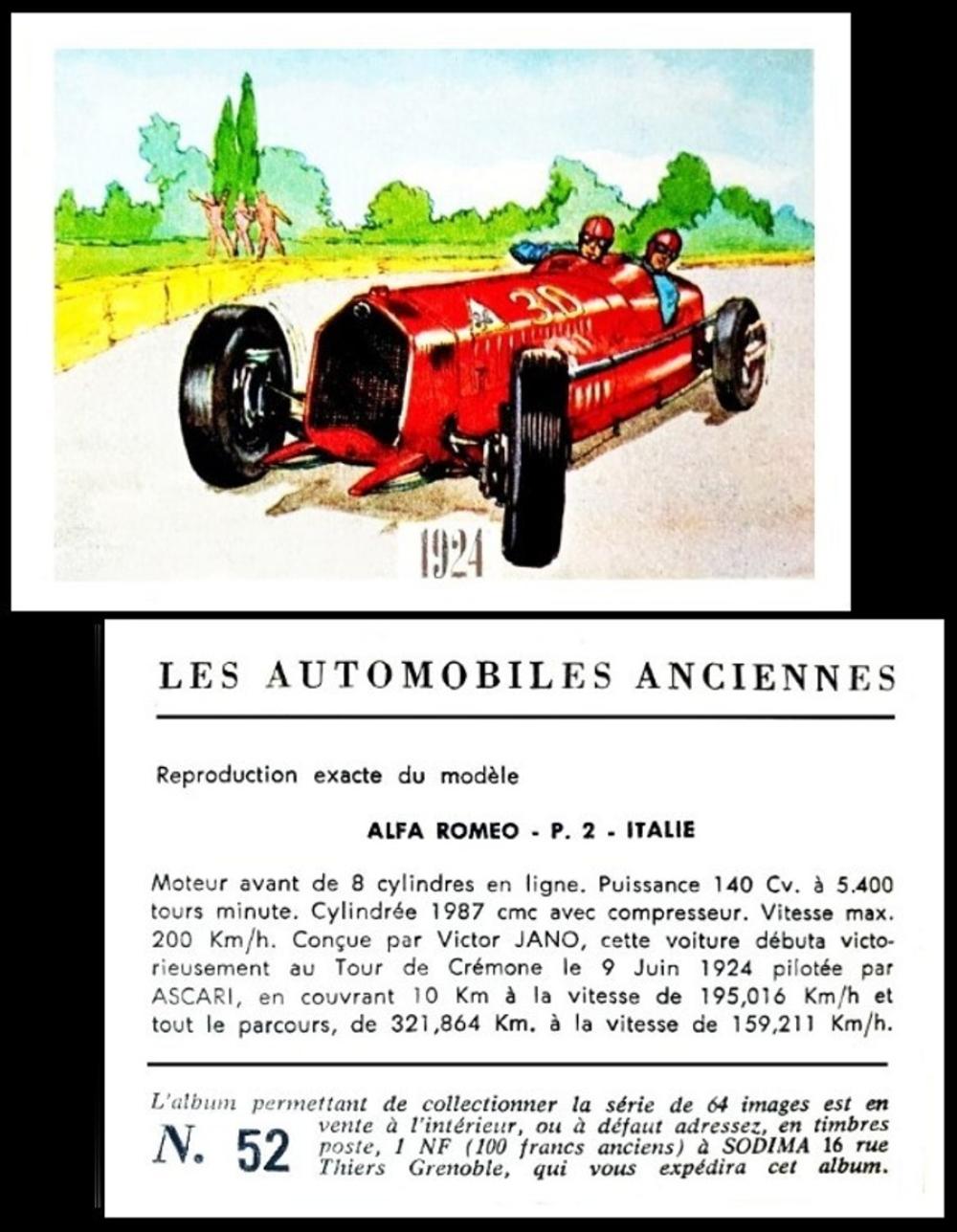
Sodima [trade? : O/S - France] "Les Automobiles Anciennes" (19??) 52/64
We also start with our first Centenary, for today in 1924 saw the French Grand Prix. Now we may be used to long seasons and over twenty races, all across the globe, but the 1924 French Grand Prix, or more correctly, the eighteenth Grand Prix of the Automobile Club of France, was also known as the 1924 European Grand Prix. It was run over thirty-five laps and there were twenty-two entrants. The returning champion was Henry Segrave, driving for Sunbeam, and he lined up in pole position, though oddly the grid was not fought out in a qualifying, as we do today, it was drawn by ballot.
In the end he did not win, he came home fifth, twenty-three minutes behind the winner, who was Guiseppe Campari, in the new car on the grid, the Alfa Romeo P2 - as shown on our card. Second, and third, places both went to Delage drivers, Albert Divo and Robert Benoist, whilst Louis Wagner, in another Alfa Romeo P2 was fourth.
As for the other two members of the Alfa Romeo team, Enzo Ferrari did not start at all as he was ill, and Antonio Ascari (mentioned on our card) did not finish, though he did do his best, and never gave up, though with a few laps to go his car began to falter, and with just one lap remaining he had no option but to go to the pits, where his engine failed to restart. An attempt was even made to push the car over the line, but it also failed, and his mechanic collapsed with the strain and excitement.
In 1925 the Alfa Romeo won two of the four championships. Antonio Ascari brought it home on the 28th of June at the European Grand Prix, in Spa in Belgium, and then Gastone Brilli-Peri drove to victory at the Italian Grand Prix at Monza on the 6th of September. However this victory was a bittersweet one, Ascari having been killed at the French Grand Prix on the 26th of July.
His son, Alberto, born on the 13th of July 1918, was just seven when his father died. He would also grow up to become a racing driver, and he too would die behind a wheel, but not quite chasing victory, for he was killed during a simple test session, for Ferrari, at Monza, in 1955.
Guiseppe Campari was also killed in a race car, again at Monza, on September 10 1933. Two other drivers lost their lives due to that same race - Baconin Borzacchini and Count Stanislaus Czaikowski.
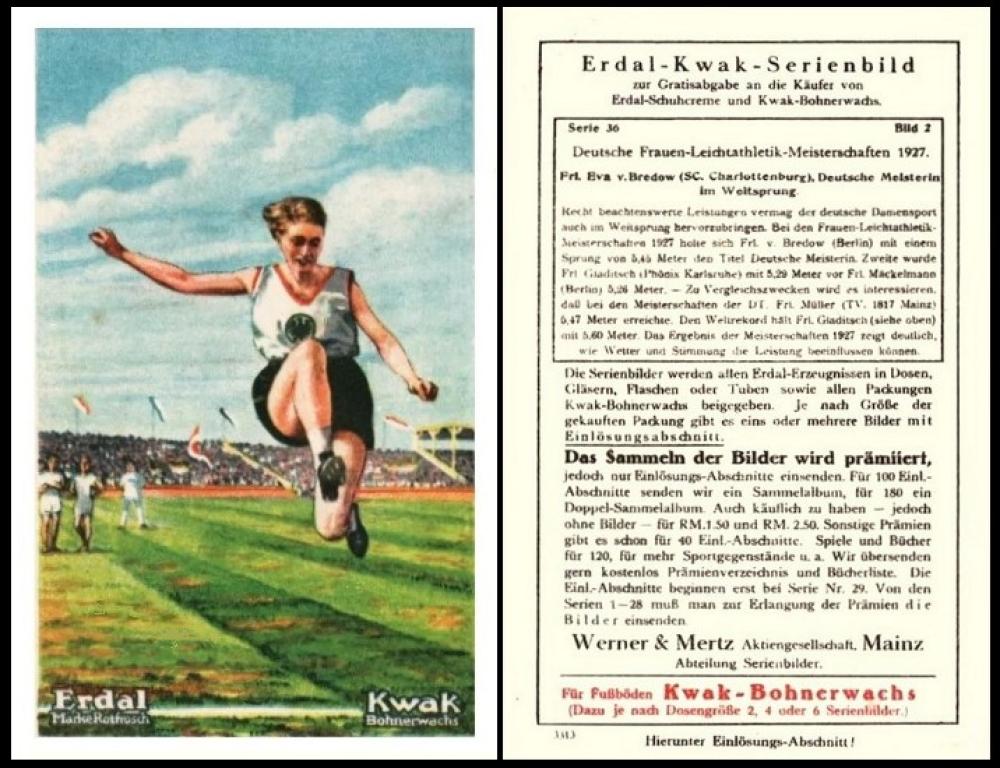
Erdal-Kwak [trade : polish : O/S - Germany] " (1927)
Our second Centenary is also a sporting one, and it marks the first Women`s International & British Games, which attempted to make up for the fact that Olympic track and field events were only for men. And, in actual fact they would later be regarded as the 1924 Women`s Olympiad, as would be the three prior runnings, 1921, 1922, and 1923 - all of which were held in Monte Carlo),
There were twelve events in our Women`s Olympiad - athletics being walking (1,000 metres), running (100 yards, 250 metres, and 1000 metres), a relay race, and hurdling - and the physical sports being the high jump, the long jump, the discus, the shot put, and the javelin. Then there were also exhibition events, in cycling, netball and gymnastics - in which were also sportswomen from Canada and the United States of America.
The event was held over just one day, the 4th of August 1924, in London, at Stamford Bridge stadium in Fulham (now the home of Chelsea Football Club), and six nations provided competitors, Belgium, Czechoslovakia, France, Italy, Switzerland, and the United Kingdom, who won the most points, sixty-one, followed by France with thirty-one, and Belgium with fifteen. There does not appear to have been any medals ?
The strange thing is that women did compete at the 1924 Olympics proper, but as a tiny proportion of the total - a hundred and thirty five women to three thousand and eighty nine men.
In fact they had competed since the second, 1900, Olympics, which saw twenty-two women accepted to play tennis and golf with other women, and compete with men in croquet, sailing, and horse riding, and Helene de Pourtales of Switzerland won a gold medal for sailing.
By 1924 women were allowed to compete in tennis (silvers to Phyllis Covell and Kathleen "Kitty" McKane and bronzes to Evelyn Colyer and Dorothy Shepherd-Barron, all in the women’s doubles event.), swimming (where Lucy Morton won the only women`s gold medal for the 200 metres breaststroke, silvers went to Phyllis Harding for the 100 metre backstroke, and Florence Barker, Constance Jeans, Grace McKenzie and Iris Tanner for the 4 x 100m freestyle relay, and bronze went to Gladys Carson in the 200 metres breaststroke) - and fencing (which brought a silver medal for Gladys Davis in the women`s foil).
Our female athlete is Frau Eva Elisabeth Gabriele Sophie von Bredow, and she was born in April 1904. She was a member of the Sportclub Brandenburg, and though she took part in many disciplines, something which was normal then, her favourites were the high jump, for which she was the world record holder in 1926, and the long jump. shown here, an event in which she was champion in 1927 (which is the date shown on this card) 1928, and 1929. Sadly she did not take part in the 1928 Olympics, though she was then at the height of her power and fame, and also despite it being the first time that women`s athletics were strongly featured - even women`s high jump, though women`s long jump was not an Olympic sport until 1948.
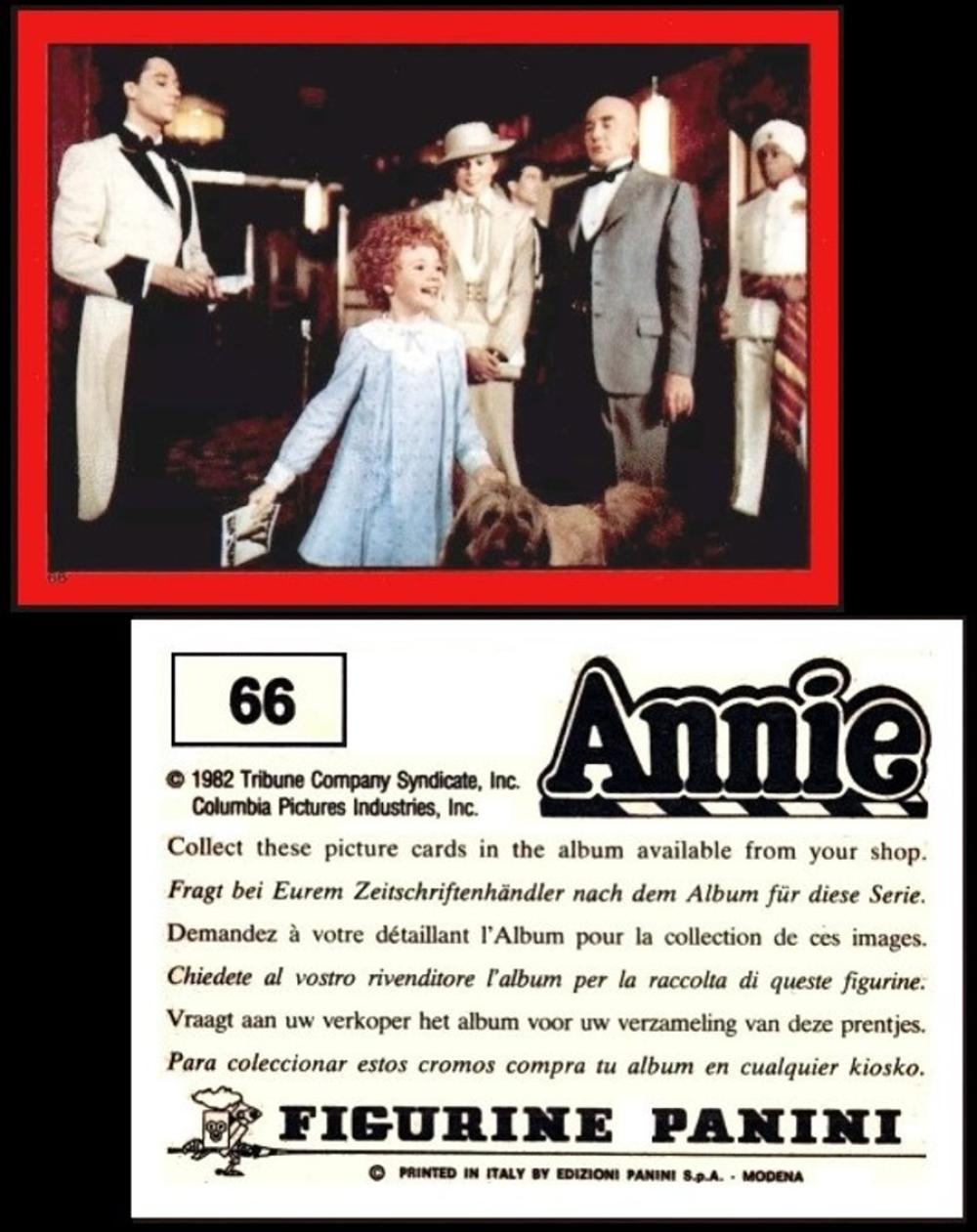
Panini (1982) /120
Lets start this third Centenary by going right back to the roots, in 1885, when james Whitcomb Riley wrote a rather scary poem about an orphan who delights in telling younger children of the ways in which they will be punished should they dare to misbehave. To her, life was to be lived in fear, and I kind of hope that one day they found someone to show them that life was actually rather magical and that misbehaving could be fun.
This tale was called "The Elf Child" but it was later changed to "Little Orphant Annie". And it was remembered when Harold Lincoln Gray sat down to draw a comic strip. However his "orphant" was a fiesty little girl, with flaming copper hair, who may have had nothing but was not scared to push the boundaries and fight for what she believed. It was probably this which led to her breakthrough, for after a succession of mean and unkind matrons she is given a chance at adoption by a rich lady called Mrs. Warbucks. We are not sure why she does this, but it is suggested that she does it to make herself feel, or look better, and when she decides to send Annie back she is persuaded not to do so simply because of what her rich friends would think. Then Mr. Warbucks comes along, he has been away on business, and takes a liking to Annie, and though she does, often, end up back at the orphanage when he goes away, she is always brought home as soon as he is back.
There is a serious point to this too, because despite her life, Annie likes people, and she is always suggesting simple ways that Mr. Warbucks can be kinder, and do more for the people who work for him at home and in business. And, in return, people are drawn to her kindnesses, as they always have been, for it is not always fine clothes and good looks that make the best of friends, it is the heart you have inside.
This sticker was issued by Panini in 1982 - the year that the 1970s Broadway musical of Annie had been turned into a film. In fact there were quite a few films starting with "Little Orphan Annie" in 1932, which starred Mitzi Green, and moving swiftly on with a film of the same title, released in 1938, with Anne Gillis. Our film starred Aileen Quinn as Annie, with Albert Finney as Daddy Warbucks and Carol Burnett as Miss Hannigan, the main matron of the orphanage. In 1999 there was another version, through Disney, and in 2014 there was one with a more racially diverse cast and the setting much upgraded, with no Daddy Warbucks, instead she was adopted by a candidate for the Mayor of New York, who was played by Jamie Foxx. Its actually quite good.
If you look at the back of our sticker you will see that it has six different languages, which basically saves the cost of printing a different back for each regional edition, everyone everywhere gets the same. And as they are designed to have the back peeled off and thrown away, leaving the sticky-side to go in the album, it was quite an easy save. Probably few collectors even noticed.
There was also a set issued by Topps, but that is the same set as ours, something that is immediately apparent when the two albums are compared, for they are identical, with just a different name above the fan of cards on the front cover. There is, of course, another alteration, and that is that the Topps album says 25c., because those cards were issued in America, whilst the Panini has no cover price.
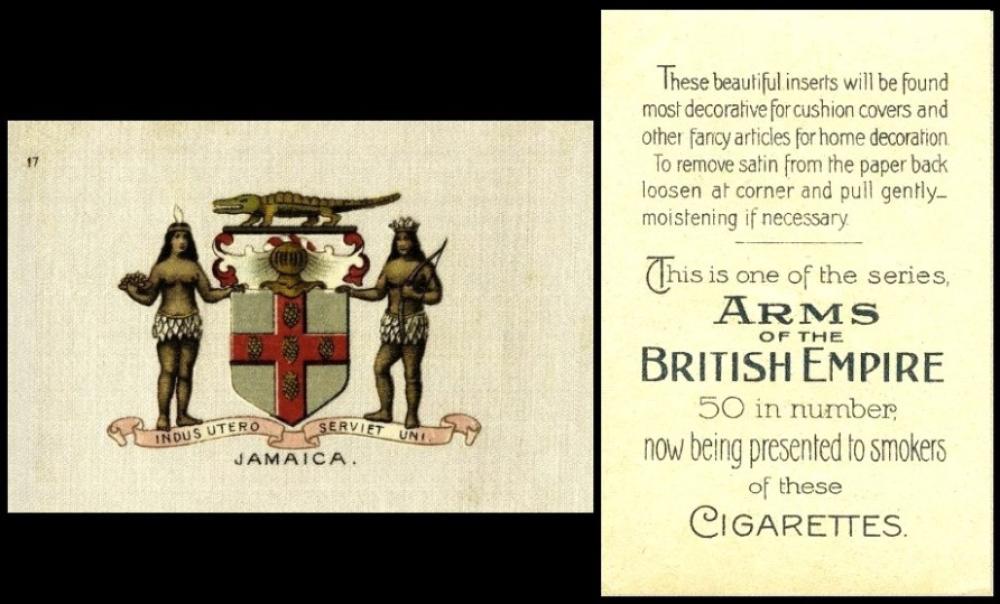
Anonymous [tobacco : O/S] "Arms of the British Empire" - medium size, silk (1910) 47/50 -
Moving forward in time now, to 1962, when, after three hundred years of British Rule, Jamaica gained her independence. I was not sure I liked this card, for it is everything that Jamaica did not want to be, but it can stay for a bit, until I discover one I like better.
Now this set was issued in several permutations, mostly by W.D. & H.O. Wills - which are ably described as part of the write up for our Card of the Day on the 4th of October 2023. However, this is the anonymous, large format silk version, and sadly it has no text on the reverse, so here is the detailed text about the arms that appears on the card version :
JAMAICA.
The arms of this colony date from the 17th century, and shew the Cross of St. George charged with five pine-apples. The supporters are two Indians, each wearing an apron of feathers, the female holding a basket of fruit and the male a bow. The crest is a crocodile on a log. This is the only instance of a colony using a sovereign`s helmet with its arms.
The pine-apple is a strange choice, because it is not a native fruit, it originally grew in South America and some were brought to Jamaica by the island`s first inhabitants, who were Arawaks, or Taino Indians. They also gave the place a name, Xaymaca, from which Ja-maica has come. It looks like the arms show a male and female Arawak, for they are described as being light brown, short, and shapely, with dark hair. The female is also carrying crops in her basket and the race was indeed very adept at growing all manner of food, plus cotton and tobacco, which they all smoked, all the time. The male, with his bow, probably harks back to the fact that they supplemented their food by catching fish, though that would probably have been done with a spear, not a bow and arrow.
Once Christopher Columbus invaded Jamaica in 1494 the Arawaks were either killed, or succumbed slowly to European diseases. In any event within a short time not a single one was left alive. The island remained Spanish until May 1655, when Admiral William Penn attacked and claimed it for England. They grew sugar there, by way of slave labour. It was not until January 1, 1808 that trading in African slaves was declared to be unlawful, though it took 1834 for them to be given the half way stage of emancipation, and full freedom was not granted until 1838.
A hundred and twenty years later, Jamaica, and ten other Caribbean countries formed a Federation of the West Indies. And today, in 1962, Jamaica was granted independence from England.
As for the set,
200-126. ARMS OF THE BRITISH EMPIRE - Silk-Fronted.
The recording in W/126 requires to be amended as follows :-
- B. Anonymous issue, with letterpress on back. Size 82 x 55 m/m. Three printings
1. Back in blue. Numbered front only
2. Back in blue. Numbered back only
3. Back in brown. Numbered front only
In the index, at the front of this book, the blue back with the numbered front is identified as having been issued in Australia.
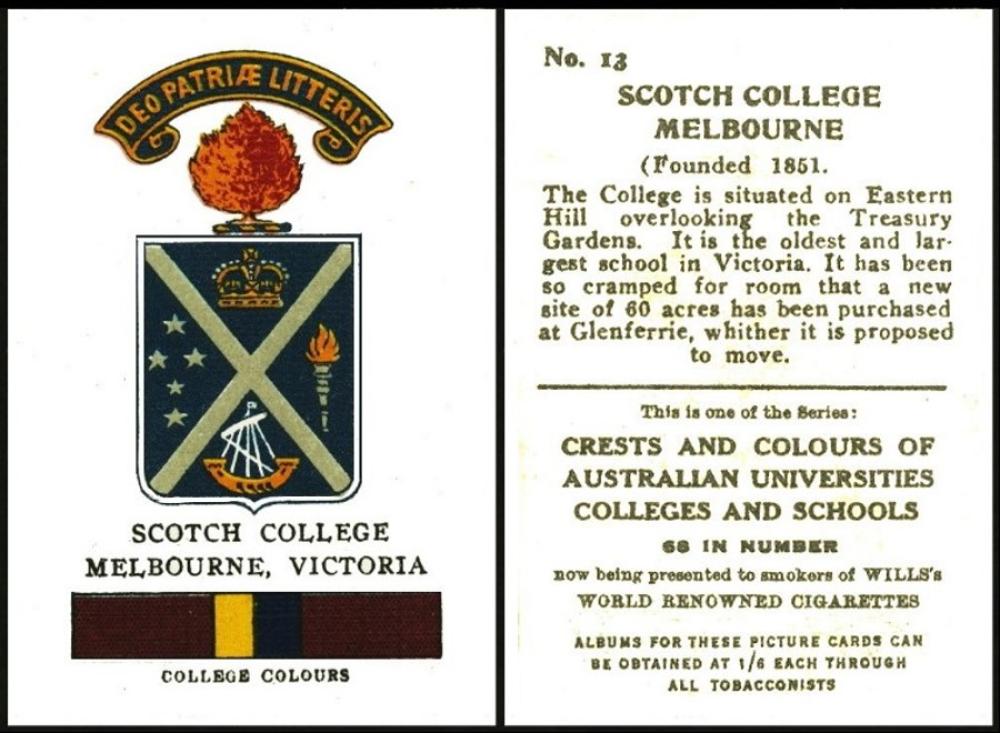
W.D. & H.O. Wills [tobacco : UK] "Crests and Colours of Australian Universities, Colleges and Schools" (1922) 13/68 - W675-405 : W62-258 : W/176
Backwards now, to 1858 and to the birth of Aussie Rules Football.
I have used this set before but as I work through the newsletters I will sort all that out - it fits better here anyway, and if you are better off not knowing the first thing that came to mind for this date.
Some of the origins of what is more properly known as Australian rules football are shrouded in mystery, mainly because it evolved from a mixture of various rules and differing styles of regional football games brought across to the country by its new inhabitants.
What we do know that Melbourne seems to have become the centre of enthusiasm for this cross breed of game, and that the first match was played between Melbourne Grammar School and Scotch College on a plot of land neighbouring to the Melbourne Cricket Ground. Now the date of this match is variously reported, but on the official memorial at Melbourne Cricket Ground it states that "The first recorded game of Australian Football was begun on the tree-dotted parklands outside the Melbourne Cricket Ground by teams from Scotch College and Melbourne Grammar School on 7 August 1858". And that is good enough for me.
Just like many of today`s sports, this was primarily a game to keep other sportsmen fit in the winter when they could not play cricket or football. However it was almost immediately popular, and on May 17th, 1859, "the rules" were officially drawn up and circulated amongst the teams, the two earliest of which were Melbourne (founded 1858) and Geelong (founded 1859).
Now our original reference book to the issues of W.D. & H.O. Wills (part IV), tells us that there is more than one version of this set, describing it as :
176. CRESTS AND COLOURS OF AUSTRALIAN UNIVERSITIES, COLLEGES AND SCHOOLS. Medium cards. Fronts in colour, backs with descriptive text. Issued in Australia.
I. Printed on satin, backed with thin board. Issued about 1922.
A. Size 70 x 48 m/m. Series of 50. Fronts without borders. Backs in black Wills` name at base. No Album Clause
B. Size 70 x 52 m/m. Series of 50. Fronts with cream borders. Backs in blue, anonymous issue. No Album ClauseII. Printed on board. Issued about 1929.
C. Size 70 x 48 m/m. Series of 65. Fronts without borders. Backs in black inscribed "Wills` World Renowned Cigarettes". Album Clause at base. Two grades of board (a) thin (b) thick.Series A and B have not been compared card for card, but appear to be similar, both in subject and sequence of numbers. Series C, issued subsequently, contains most of the 50 designs in the earlier issues, but the colouring and in some cases the descriptive text, varies considerably from the corresponding cards in A and B. The numbering sequence in all three issues appears to be identical up to No.25, but subsequent numbers in C vary from those in A and B, cards in C usually occurring one number lower than the similar subject in A and B.
In our original World Tobacco Issues Index, I can only find it once, described as :
CRESTS AND COLOURS OF AUSTRALIAN UNIVERSITIES, COLLEGES AND SCHOOLS. Md. 70 x 48. Nd. (68). See W/176.C.

Net Pro Trading Card Company [trade/commercial : cards : O/S - USA] "Net Pro Elite - Event Starter" (2003) S2/10
Jump in our time machine again, and lets land at 1981, which was the birth date of tennis ace Roger Federer. He was born in Switzerland, as you may have guessed from the flag on this card, and he was Junior Wimbledon Champion, both in the singles and the doubles, in 1998. He had also been a ball boy there, some years before.
His first major adult win was in 2003, when he was twenty-one, and that is the year of this card. However it is not his "rookie card" - and there is some dispute as to what is. Top seed seems to be a sticker which came, in a sheet, with others, as the centre spread of Tennis Plus Magazine in September 2000 and had to be cut to size. However some people discount this because it is a sticker, and they will argue, somewhat pedantically, that his "Rookie" card was issued with Tennis Plus Junior magazine in 2001. This was also issued as part of a sheet, and had to be cut to size, but it had a printed back whilst the sticker only had a logo.
Mr. Federer was very popular and a great player, being ranked as World Number One for two hundred and thirty seven weeks without a single week off the top. He won a hundred and three singles matches, incliuding eight Wimbledon Men`s Singles Championships, and five U S Open Men`s Singles Championships, plus a silver medal at the London Olympics in 2012. He also won a gold medal, with Stanislas Wawrinka in the Doubles, in 2008, at Beijing..
In 2016 he had knee and back surgery. He freely admitted that in his youth he had suffered pain rather than give up and get treatment. It was thought he would not return to the sport, but he did, as early as 2017. However he gave up for good in 2022, devoting himself to charitable foundations which he either created or supports, chiefly those which help children, either to find themselves through sport or to bounce back after illness. He is also married, with four children.
And the trading card database/RogerFederer has him on 1,006 cards.
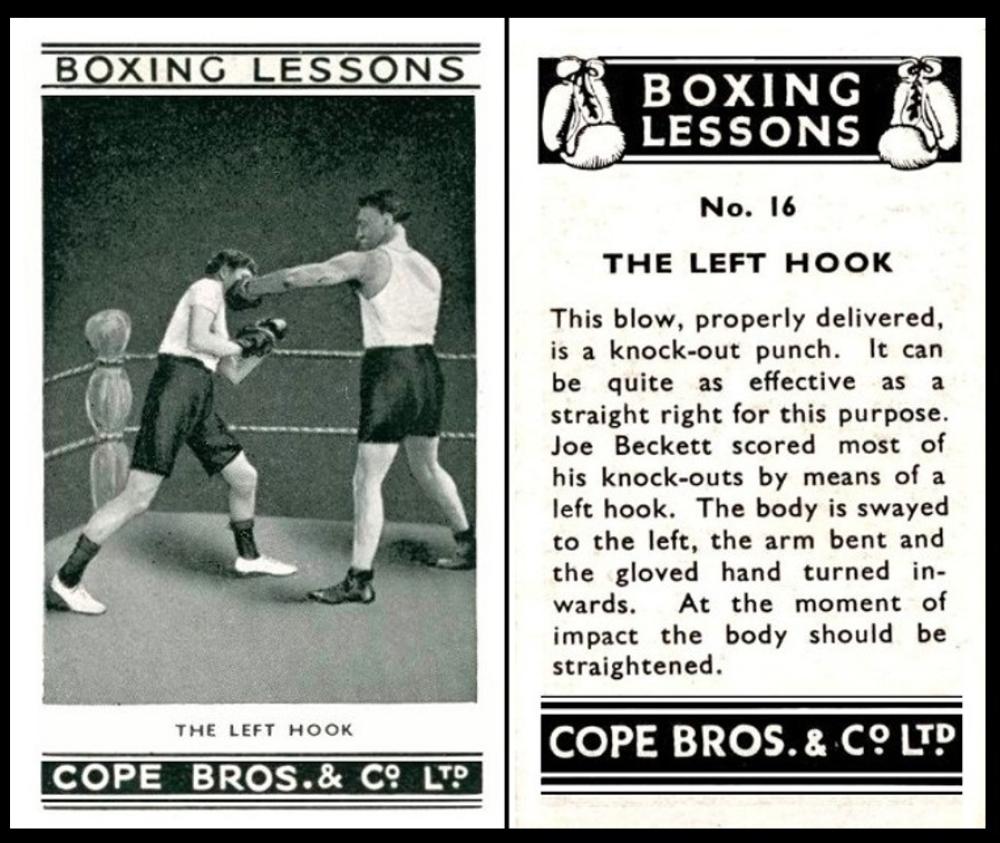
Cope Bros & Co. Ltd [tobacco : UK - Liverpool and London] "Boxing Lessons" (1935) 16/25 - C798-620 : C132-71
Last, but not least, we return to a Centenary card, because today in 1924 saw the first boxing match at the Wembley Stadium, Tommy Gibbons vs Jack Bloomfield. And it ended in a knock out, by Tommy Gibbons, in round three, which is why we have this card.
Thomas Joseph "Tommy" Gibbons was American, and was not too young at the time of the match, having been born in 1891. He did appear on cards and ten of them are cited in the Trading Card Database/TG - whilst Jack Bloomfield, or more correctly Sol Blumenfeld, of Islington in London, was eight years younger. He only appears on three cards, which you can see at the Trading Card Database/JB
This is a fascinating set, and seems overlooked in favour of the 1915 "Boxers", also issued by Cope. However if you look closer at our cards, many of them feature named boxers - including Georges Carpentier on card 25.
Sadly, no reference booklet was issued for Cope, so we have only the cataloguing from the original World Tobacco Issues Index, which reads :
BOXING LESSONS. Sm. 63 x 37. Black and White. Nd. (25) ... C132-71
The text is identical in our updated version, save a new card code.
This week's Cards of the Day...
This week’s “Theme of the Week” is something we all ought to take part in, and that is Cycle to Work Day. This event will be held on the first of August so there is lots of time to polish up your pedals and fiddle with your frame. There is even a competition, running through CycleScheme and you can go have a look at that by clicking their name in bold above. Now, as often happens, if you are reading this in America, you have a different day (actually it was on May 17th) - but there is nothing to stop you having fun and joining in on our day too.
So why, you may ask, should I cycle to work? Well the personal one is that it makes you fit and keeps you healthy. As for the ecological one, well that is because your bicycle is more planet friendly than your car, not just because of the lack of fumes, but because most of the people who can bicycle to work on their own would often otherwise drive there in a car large enough to carry four people, at least. Something to think about as you pedal merrily along...
We are not sure about the origins of the day, as facts conflict, and everywhere that has it as a day seems to have it on a different one. Several sites claim that it was started in America by the League of American Bicyclists in 1956, but that it did not spread in to the United Kingdom until 2012/13. Now 2012 was the Olympic Games here in the United Kingdom, so perhaps investigating that link will be profitable.
So our clue cards this week were :
Saturday, 27th July 2024
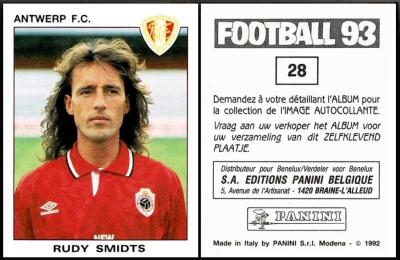
The clue here was a devious one, but it referred to the club, Royal Antwerp F.C., which is one of the most bike friendly clubs, with parking for 1,600 cycles. In fact they converted part of a car park into split level bike parking.
And they also recycle every beverage cup sold at the stadium by introducing a deposit and refund system.
There is another clue too, because bicycling is a very good sport for fitness, especially on the legs, and it is starting to be used to develop the hamstring muscles and make them more resilient to in-match strains.
Our man is actually Rudolf Smidts, and it is almost his birthday, for he was born on the 12th of August 1963. FC Antwerp was his club, for most of his career, though he is also an international player and you might have even seen him in the 1994 World Cup.
These cards are entirely different from the ones issued in the United Kingdom, which have yellow banners to the front.
You can see a complete checklist of our set at Last Sticker/P94-Belgium, though do note that they call the set "Panini Football Belgium 1992-1993". There are also similar checklists from this current year right back as far as 1970 on their main Belgian Football page - which is even before the stickers were Panini ones.
Sunday, 28th July 2024
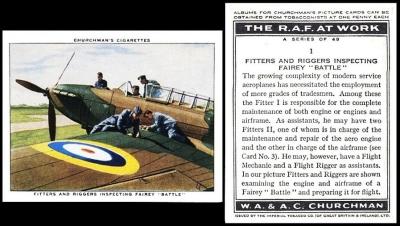
This card gave us the "work" part of the clue, but also there was an even better reason as to why we included it as some of you may have remembered personally, or been told by your relatives, that R.A.F. pilots used to practise their flying skills by riding on bicycles.
You can read more about this at AWM.gov.au
I am surprised I have not used this set before, it is a really interesting one, and the colour is a vast improvement on the earlier "The Navy at Work", which were half-tones in dark green.
I often wonder at who the people were on such cards. Did they ever know for what purpose their photo was taken? Did they ever get a surprise when they found themselves amidst their cigarettes? Most of all, is this, perhaps, the only surviving image of a man killed so young - and did their families, or descendants, ever get to know, or see it ?
The set is catalogued in our original Churchman reference booklet, RB.10, issued in 1948, as :
116. DEC 1938. 48. THE R.A.F. AT WORK (titled series). Size 2 7/10" x 2 1/10" or 68 x 53 m/m. Numbered 1-48. Fronts printed by letterpress, 4-colour half-tone process. Backs in dark green, with descriptions, album clause and I.T.C. Clause. Printed by Mardon, Son & Hall.
117. 48. THE R.A.F. AT WORK. Identical to (116), but omitting album and I.T.C. Clauses. Overseas issue.
By the time of our original World Tobacco Issues Index, the text is much reduced, to just :
THE R.A.F. AT WORK. Md. Nd. (48) ... C82-75
The updated version of the World Tobacco Issues Index has exactly this wording, just a different code.
By the way, you will find the overseas printing in a new section that follows on below the British issues - it is coded C82-98 (or C504-780)
Monday, 29th July 2024
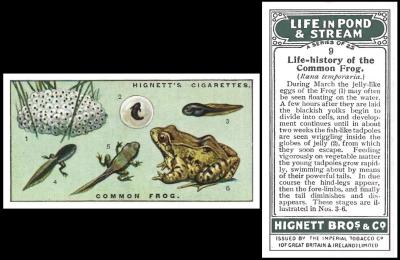
This gives us the "Cycle" part of our clue, the "life-cycle" - or, as it says on the card, the "Life History" - of the Common Frog. And indeed it is a cycle, for the frogs lay eggs, which hatch, change, and turn into frogs - and at the age of just two or three they are ready to lay eggs of their own.
It is a much similar story for us, except that we take longer about it, and have far less progeny, though that is simply because we have less predators than do they. It is estimated that just one in fifty of those eggs will make it out of the pond to breathe on land
This is a very interesting set which includes all kind of life to be found in and around the water, beetles, fish, a water vole, reptiles and amphibians. It would be treasured by collectors of wildlife and gardening cards and yet it seems little known.
Sadly, it is not one of the sets which were also issued by Ogden`s, so we cannot add any details of its manufacture. It was also too early for any cartophilic magazines, so all we have is the cataloguing in the World Tobacco Issues Index, namely :
LIFE IN POND & STREAM. Sm. Nd. (25) ... H44-36
This is identical in our updated version, except for the code.
Tuesday, 30th July 2024
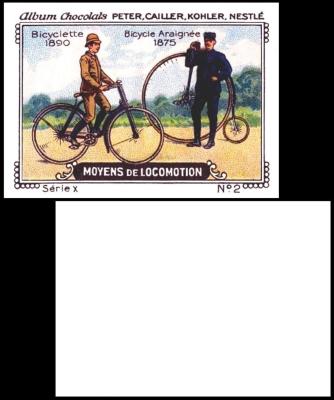
This is another of those lovely thin paper cards, and it introduces the bicycle itself.
Now this shows two bicycles, the one on the left which is titled "Bicyclette 1890" and the one on the right, "Bicycle Araignee 1875". Starting with this one, on the right, which we call the penny farthing, simply because of our coinage, where the penny was the largest copper coin (representing the largest wheel) and the farthing was a quarter of a penny (so stood for the smallest wheel). This machine revolutionised bicycle riding, though it looked odd - the front wheel provided the power, hence the speed, and the simple fact is that a larger wheel covered more ground with each turn of the pedal.
However you may not realise that this machine originated in France, and was actually invented in 1869 by a Parisian resident called Eugène Meyer. He is said to have called it the high level bicycle - also known as the "Grand" (which in French means large) - though on our card, remember, it is called the "Bicycle Araignee", which means the spider. This could refer to the fact that the rider perches on top, like a spider in a tree waiting for his prey, or it could be more technical, because in bike parlance a spider is part of the drivetrain, and it is quite easy to spot because it is a circle with "arms" extending out. Sometimes they are called spider rings too. The truth seems to be neither of these; they seem to have called it the spider because the wheel hub was in the middle of all those lines, and it looked like a black spider in the middle of a web.
In fact, the "boneshaker" was French too, and you can tell that from its proper name, of the Velocipede. And the Velocipede does not have a spider as part of its drivetrain, which seems to support theory number two.
Something else is intriguing about this card, because both riders seem to be in uniform, the man in the front in khaki appears to be sporting a pith helmet for use in tropical climes, and the man in blue behind sees to have the kind of cap a postman would wear, though in military parlance it was known as a "kepi" and is thought to be where the word "cap" comes from, in fact it was the main military headwear throughout the French Army for many years.
And, bringing us back to our theme of the week, the Army, worldwide, was also one of the first "employers" to issue their "staff" with bicycles, for taking messages, and then for all manner of military purposes where noisy and heavy vehicles would not do. In fact you can see a "Cyclist Scout Section" on card 15 of John Player`s "Army Life", where the text tells us that "Cyclists are a very great advantage for scouting and the carrying of despatches, and a good deal of encouragement is given to the exercise of this sport in the Army. There are certain recognised cycling sections in which men receive an allowance for machines. Commanding officers now permit of regimental funds being used to purchase in large quantities, and they are supplied to serving soldiers at a low figure on the hire-purchase system."
You can also find this set as "Serie 10" rather than "Serie X", and in a later printing again, which is easily distinguished by the fact that it has a capital letter in the middle of the bottom white border. The cards included are :
- Draisienne 1818
- Bicyclette 1890, Bicycle Araignee 1875
- Automobile de Stafford 1859
- Limousine 1915
- Locomotive Compound 1830
- Type P.L.M. a Grande Vitesse 1912
- Chariot Helvete
- Char Egyptienne (Egyptian Chariot)
- Char Roman
- Carosse Henri IV 1600
- Palanquin XVe siècle, litter
- Coucou XIXe Siecle
Wednesday, 31st July 2024
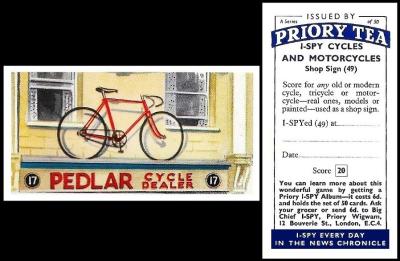
This card is rather exciting, because it shows that bicycling has risen to the popularity that dedicated shops were set up.
And, though our younger readers may not believe it, it was very common once to use an old bicycle above a cycle shop as advertising, often brightly painted with a board for extra advertising. In fact this card awarded twenty points for "any old or modern cycle, tricycle, or motorcycle - real ones, models, or painted - used as a shop sign".
This shop is a bit of a play on words, "Pedlar" meaning one who pedals a bike, as well as a dealer of goods. Though a swift internet search proved that "Pedlar" is often used as part of bike shop names to this day.
According to the Guinness Book of Records the oldest bicycle shop in existence is Pearson Cycles in Sutton, London - it started in 1860, but as a wheelwright, making wheels for horse-drawn carts, for at one time Sutton was a rural place. It obviously then saw a need for bicycle wheels, or perhaps someone broke a wheel outside their premises and they made the link. And, quite wonderfully, it is still a bike shop at the time of my typing.
However it took until 1926 for there to be a British bicycle manufacturer - that was Pashley, of Stratford-upon-Avon.
We have a main page for Priory Tea - I Spy with some background info on the company, and a listing of all the sets, and, one day you will be able to see a specimen card from every set by linking out from there. Not yet though.
This set is described in our original British Trade Index part two as :
SERIES 9 "I SPY CYCLES AND MOTORCYCLES". Sm. Nd. (50) ... PTT-9
It also marks a big change in the series as it was the first set of fifty cards, those prior were only of twenty-four cards. There is a theory that says they did originally plan it as two series, one of cycles and one of motorcycles, but then decided to join the two together.
Thursday, 1st August 2024

Is there a Cibils specialist out there? I know nothing of this card, or to which set it belongs. Help us out, please, if you can.
I do know that the first cards were issued by Cibils in the 1870s - thanks to chromo.be/Cibils. However it was not until 1881 that Jaime Cibils Buxareo, of Uruguay, bought a farm in Mato Grosso and a rather run down beef jerky production faciliy in Descalvados. I shall move away, quickly, from thinking about this awful connection, before the tears roll down my face, and just say that as Descalvados is mentioned on our card we know that it was issued after 1881.
This one shows something which has come full circle, delivering goods by bicycle. This is great ecologically, but not just because of the removing of the emissions of the former vans and cars, for what is often not considered is that in order to have your goods delivered by bicycle you are supporting a local retailer, and also making employment for local people, those who ride to you, and those who work in the store from whence it came. Our part of, dare I say, this "chain", is simply to ensure that we know which stores use bicycle delivery and to prefer them when we make our purchases.
Thanks to readers, and also to J.S. Cards, who is currently selling a set, I now know that this set is called merely "Bicycles", and that all but one card are actually showing bicycles being used for work purposes, unless maybe the Auto Tricycle is chauffeuring the lady and not just on a pleasure trip into the country, or a very early version of the rickshaw? The Estafette is interesting to me, because that name was used for the kind of Renault which was a bread delivery van in the 1960s, but was also widely used by les gendarmerie.
In case that set gets sold I will add in the titles of the cards, which are :
- Auto Tricycle [a man driving a lady, the lady sits in front]
- Commissionaire et Velo pour rendre a Domicile [home delivery bicycle]
- En Chasse [huntsmen]
- Estafette Francaise [courier]
- Facteur et Ramoneur [postman and chimney sweep]
- Pompe a Incendie [fire brigade] ..
Friday, 2nd August 2024
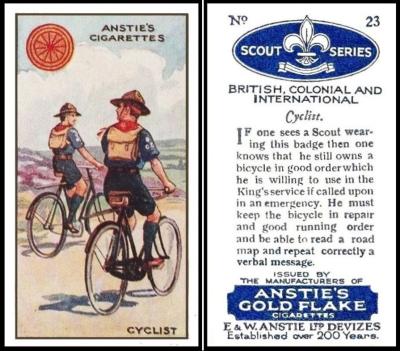
This set first appears in our original reference book to the issues of Abdulla, Adkin and Anstie (RB.5, published in 1943) as :
1923. 50. SCOUT SERIES (titled series). Size 2 11/16” x 1 7/16”. Fronts, printed in four colours by letterpress from half-tone blocks. Subjects titled and “Anstie`s Cigarettes” at head. Border lines and white margins. Backs, printed in blue, with descriptions and “Issued by the Manufacturers of Anstie`s Gold Flake Cigarettes”.
Now the booklet did not give code numbers to the sets but the previous owner of my booklet (who was a Dr. George A. P. Fraser, if anyone has anything else of his in their collection, or can tell me a bit about him), has counted them and numbered each one in pencil, this being “23”, so that is where the A/23 comes in at the top.
And that brings us neatly to a close, in good time too. I have much enjoyed writing this week`s edition, indoors with a glass of lemonade out of the sunshine and its wilting power. I have not had a lot of time, but I have chosen wisely and I hope you will agree.
We are now coming towards a time when there are four previous newsletters for that week, which I will do my best not to repeat of subject or card. This makes life a little harder and a little more fun. I am glad to say, though, that I have several correspondents with vast collections of Continental cards, and they are enjoying sharing them. And if you have a collection that you would like to share with us (anonymously, of you wish) do please get in touch at webmaster@card-world.co.uk
